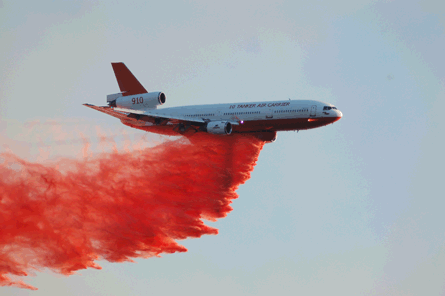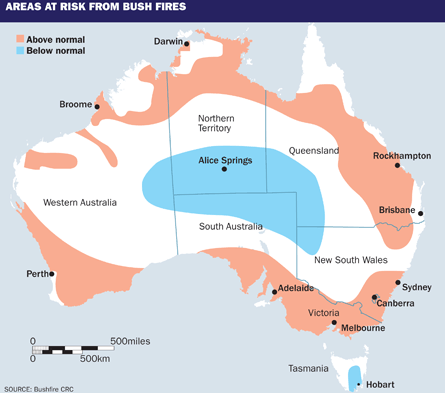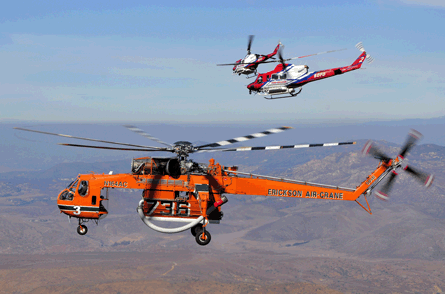 |
|---|
© 10 Tanker Air CenterThe DC-10 can hold 45,000 litres of water or fire retardant and can reach anywhere in Victoria in 45 minutes |
Tooday in Western Australia and a number of other parts of the state had received a "catastrophic" rating for the first time since the new fire danger rating system was introduced following Victoria's devastating Black Saturday fires in February 2009.
Temperatures of more than 40°C (104°F), coupled with strong winds, resulted in the catastrophic rating, during which residents facing a fire threat are advised to leave their properties because staying and defending would be futile in such conditions.
This is not the first time the catastrophic rating has been used, with parts of South Australia encountering similar conditions just before Christmas.
WARNINGS
Parts of Victoria, New South Wales and Queensland have already experienced fires since the current season started in late August/early September in Queensland, kicking off in other parts of the country in November/December. No doubt catastrophic warnings will be issued throughout the season, which continues until April in Western Australia.
Fire authorities are bracing for a particularly bad fire season, with large areas of populated regions facing an above normal fire potential, according to the Bushfire Co-operative Research Centre (CRC) - the body that was set up to study the social, economic and environmental aspects of bushfires. The CRC comprises more than 30 fire and land management agencies, universities and government agencies.
The catastrophic fire rating is just one change that has been introduced since the Black Saturday fires - the worst bushfires in Australia's history, in which 173 people lost their lives, more than 2,000 homes were lost and more than 400,000Ha (990,000 acres) of bush was burned.
BUSY 2008-09 SEASON FOR NATIONAL FLEET During the 2008-09 fire season the National Aerial Firefighting Centre (NAFC), the body responsible for arranging a fleet of aircraft to be used for firefighting and air attack supervision throughout the country, had a pooled fleet of 43 aircraft - the highest number used to date. States and territories also have their own firefighting fleets. During the season - considered an extreme one - the NAFC's pooled fleet was activated more than 1,300 times for 14,800 drops delivering over 34 million litres (9 million USgal) of water and retardant - more than double the figures for the previous fire season. New specialised capabilities were introduced, says the NAFC, including a helicopter based in New South Wales equipped for aerial intelligence gathering, while a high-volume heavy helicopter was based in Adelaide for the first time. The first aircraft went into service on 25 August 2008, in Queensland, and the fleet continued operations until 28 April 2009 in Western Australia, with the fire season lengthening each year. The season was characterised by bursts of activity, with significant fires, says the NAFC, culminating in the catastrophic events of 7 February in Victoria. |
Since the fires, fuel-reduction programmes have been expanded: a new national emergency warning system has been developed with warnings to be delivered to those at risk through mobile and fixed telephones, while fire preparation and firefighting resources have been boosted, including the aerial fire monitoring and firefighting fleet.
In Victoria alone more than A$50 million ($45.4 million)-worth of new initiatives have been introduced or are under development. Further changes are likely to be introduced as the Royal Commission, which was established to investigate the Black Saturday disaster, is ongoing. Aerial firefighting is set to be addressed by the commission.
Among new initiatives in Victoria is a A$10 million trial of a very large air tanker (VLAT) - the first-ever such experiment in the country. On 14 December, a McDonnell Douglas DC-10-30 Super Tanker, leased from US company 10 Tanker Air Carrier, arrived in Melbourne. Australian regulator, the Civil Aviation Safety Authority, and underwent final compliance assessment to allow it to enter service in January.
The aircraft is contracted to operate until 18 March, unless the agreement is further extended, says Rick Hatton, managing partner of 10 Tanker Air Carrier.
FIREFIGHTING
Based at Melbourne's Avalon airport, the aircraft will be used in actual firefighting, providing it is safe and appropriate to the situation, says the National Aerial Firefighting Centre (NAFC), the national body responsible for arranging a fleet of aircraft to be used throughout the country for fire bombing and air attack supervision. It was the NAFC that arranged the lease of the DC-10.
The aircraft will also be available to other states if requested, which is normal under resource-sharing protocols, says NAFC general manager Richard Alder.
The DC-10 Tanker 911 - or Bomber 391 as it will be referred to during the trial to fit in with Australia's call sign system - can hold about 45,000 litres (11,900USgal) of water or fire retardant and has an operational radius of 925km (500nm) at 310kt (575km/h) - capable of reaching anywhere in Victoria in 45min.
It is one of two DC-10 tankers developed by California-based 10 Tanker Air Carrier. The aircraft comes to Australia fresh from firefighting trials in California, where the widebody has proven to be extremely effective in building fire-breaking lines and contributing to wildfire containment, says 10 Tanker Air Carrier.
It features a retardant tank supplied by Oregon-based Jordan Air, with a variable drop rate that is cockpit controlled and has a refill time of 10-20min.
This is the first operation for the tanker outside the USA, says Hatton. "We look forward to the DC-10 being every bit as successful here as it has been on a variety of fires in the western USA, where it has been a real game-changer," says Hatton. To date, 10 Tanker has flown 340 missions to 47 fires, delivering more than 13 million litres of suppressant.
Firefighting operations in Australia are similar to those by the US Forest Service and the California Department of Forestry and Fire Protection (Cal Fire), with the principal difference being terminology, says Hatton.
He adds: "The infrastructure at Avalon is very similar to our Californian bases. Essentially all we need is a jet runway, ramp space, fuel, an adequate water source and a mobile mixer for retardant. With this we will be able to experience quick turnarounds - 20min or less. Our quick turnaround combined with our 45,000 litre payload capacity and jet speed to and from the fire makes the 10 Tanker capable of putting more suppressant on a fire in a day than any aircraft in fire service."
RESEARCHERS DELIVER 2009-10 WARNING The Bushfire CRC predicts above normal fire potential for large parts of the country for the 2009-10 fire season. Most of south-east Australia, comprising all of Victoria, south-eastern New South Wales, the Australian Capital Territory (ACT) and the southern areas of South Australia, as well as the south-west land division of Western Australia, are rated by fire and land management agencies as having a high level of fire potential for the current season. This is due in many parts of the country to increased grassland fuels following winter rains combined with El Nino conditions, coupled with above average spring temperatures, while other parts of the country, such as Victoria, are extremely dry due to a persistent lack of rain. Unseasonable fire activity occurred early in a number of areas, according to the Bushfire CRC. Thanks to above average rainfall, Tasmania has a normal or lower than normal fire potential, while following years of below average rains in central Australia there is little fuel and as a result the area has a below average fire potential. |
Victoria's police and emergency services minister Bob Cameron says firefighting agencies will need to determine how very large air tankers work in Australian conditions. "Victoria will test how effective the big machines can be in fighting fires in conjunction with our current fleet of smaller firefighting aircraft," he adds.
The DC-10 joins a fleet of 34 firefighting aircraft and helicopters leased for the fire season to fight conflagrations in the state, with access to a further 176 fixed-wing aircraft and 38 helicopters that are on call.
The DC-10 was selected based on its operational performance in the USA, which has similar landscape characteristics to Victoria, says Cameron.
The large air tanker will be "rigorously" tested, says the NAFC. It will be assessed for immediate attack when a fire is small, its impact on a developing fire to help contain it and on a control line. Victoria also plans to test a new suppressant gel as an alternative to traditional foam for firebombing.
OPERATIONAL REVIEW
The Bushfire CRC will deliver a scientific and operational review of the aircraft's effectiveness for Victoria's fire agencies after the 2009-10 bushfire season, with the NAFC contributing A$500,000 towards the review.
The DC-10 trial is not a knee jerk reaction to the Black Saturday fires, although it is a concrete signal to the public that the Victorian government is addressing all aspects of fire management and suppression.
The NAFC has been evaluating VLATs for some time. In early 2008 it released a Future Aerial Fire Management Capability request for proposals that included evaluating VLATs. Since then the NAFC has been in discussions with suppliers and closely following the use of the DC-10 and Boeing 747 Supertanker in the USA, including a visit by NAFC personnel in February 2009 to California to watch the aircraft undergoing trials and drop pattern testing. It is believed the NAFC was looking at a VLAT trial in Australia for the 2010-11 fire season, but the Victorian government started discussions with the NAFC in September and fast-tracked those plans.
Issues of cost-effectiveness and ground infrastructure have previously meant VLATs have not been used in Australia, with such types considered at a cost disadvantage, according to the Bushfire CRC's study on The Effectiveness and Efficiency of Aerial Fire Fighting in Australia, particularly in the case for first attack when fires are small and where water drop accuracy is required.
That study aimed to help fire agencies identify the most effective combination of suppression resources for minimising the impact of bushfires. The study, which involved the collection of data from 284 incidents that used aerial suppression, found that the method can be effective in providing support to ground crews and improving the probability of first attack success by 50% or more.
The effectiveness of aerial fire suppression depends on many factors, including aircraft travel time, distance from the fire, aircraft characteristics, drop characteristics, ambient conditions, availability of support ground resources, fire intensity, fire size, fuel type, pilot skill, suppressant agent used and organisational and infrastructure arrangements.
For an aircraft to provide effective assistance it must be available at call, rapidly dispatched with minimal travel time and with logistical systems in place. Furthermore, air operations effectively intregrated into the incident management structure and competent personnel are needed to be available to direct the operations for good outcomes, the report concludes.
The use of ground resources with initial aerial support is the most economically efficient approach to suppression and the use of aircraft for first attack until ground resources reach the fire produces the best suppression outcome, it adds.
MESSAGE OF HOPE
The study also found that aerial suppression and other use of aircraft conveys a strong psychological message of hope and "can do", with the use of aerial firefighting providing a morale boost for the public and firefighters.
The Bushfire CRC has also examined the cost effectiveness of aerial firefighting in Australia, concluding that the use of ground resources with initial aerial support is the most economically efficient approach to fire suppression. Helicopters are the most economically efficient approach for the suppression of remote fires, according to the report.
Helicopters also perform economically better than large air tankers, with the latter able to carry large volumes of water, but also requiring a longer turnaround time and having substantially higher operational costs. High volume helicopters and fixed-wing aircraft are economically more efficient in fire suppression, compared with small helicopters and large air tankers, according to the report.
 |
|---|
Other than the trial of the DC-10, Australia's aerial firefighting strategy remains largely unchanged for this season. The NAFC has leased more than 40 aircraft and helicopters for the current fire season. The NAFC receives funding from the federal government -A$14 million a year over four years - which is matched by the states and territories. In return they get a pooled aircraft and helicopter fleet and supplement this with their own aerial resources.
The national fleet comprises Air Tractor AT 502s, AT602s and AT802s; Bell 205s, 206s, 212s and 214s; Cessna 337s; Erickson S64 Aircranes; Eurocopter AS350B3 Squirrels; Kawasaki BK117s and Sikorsky S-61Ns.
Australia has found that aircraft that work best in its conditions are a mix of type one helicopters, with a capacity of up to 2,650 litres; type two medium helicopters, with a 1,135-2,649 litre capacity; type three light helicopters, with a 380-1,134 litre capacity; and single-engined fixed-wing firebombers.
Whether VLATs have a place in that mix will perhaps be answered at the end of this fire season.
ELVIS COMEBACK HERALDS START OF LONG HOT SUMMER
WHEN THE Erickson S64 Aircrane Helitankers arrive in Australia you know summer has started. Elvis and Elsie are familiar names to the Australian public, with the Aircranes having operated in the country's fire season for the past 12 years. Elvis, in particular, gained national fame during the Black Christmas fires of 2001 when it helped to save hundreds of homes around Sydney.
For the current fire season there are six of the type in the country, including Elvis, Elsie, Isabelle and Georgia Peach - five on contract and one spare. Melbourne and Sydney have two each, one is in Adelaide and the spare is in Melbourne.
Two helicopters arrived in November - a month earlier than usual - with the rest of the fleet arriving in December. The helicopters are on contract for 12 weeks, although this may be extended, depending on how the season pans out, says Erickson's firefighting manager in Australia, Mark Robertson. Through local partner Helicorp, the fleet is in the second summer of a five-year contract. In total the fleet has a 70- to 80-person support crew.
 |
|---|
© EricksonThe S64's manoeuverability and precision-drop capability contribute to its firefighting effectiveness |
The S64's manoeuvrability and precision-drop capability makes it a highly effective firefighting tool, says the Oregon, US-based manufacturer, which purchased the type certificate for the Sikorsky S64E and F Skycranes in 1992 and changed the designation to the S64 Aircrane. It can dump up to 10,000 litres (2,640USgal) of water, foam mix or fire retardant at speeds and distribution ranges programmed into an on-board computer.
The tank system attaches to the helicopter through eight hardpoints on the fuselage and has been designed to give the air attack co-ordinator more control over where and how the drops are made. It has microprocessor-controlled tank doors that allow for eight different coverage levels.
"The tank adds the delivery capacity of fixed-wing tanker planes to the manoeuvring capability of a helicopter," says Erickson.
A high-volume hover snorkel hose uses a self-priming hydraulic pump to fill the tank in as little as 45s from any water source at least 45cm (17.7in) deep, says Erickson, adding that the helicopter has achieved the quickest turnaround times of any aerial bushfire asset. The water cannon attachment, developed to fight high-rise structure fires in congested inner city areas, forces a stream of water or foam mix at 1,140 litres per minute with a coverage range of 60m (195ft). A special sea snorkel augments the freshwater fill capabilities of the hover snorkel by refilling the tank in saltwater sources as well as freshwater ones. Refill with the sea snorkel is achieved by skimming above the water surface at 35-45kt (65-85km/h) as the hydrofoil ram scoop forces water up and into the tank. With the sea snorkel, refill can be achieved in 30s, says Erickson.
The Aircrane has become the mainstay of the US Forest Service aerial firefighting fleet and has been sent to fires throughout North America, Europe and Asia. Four machines helped quench Victoria's Black Saturday fires last year.
During the last fire season the fleet operated for around 400h in Australia, says Robertson.
"The indications are [this season] is going to be warmer than usual and drier," says Robertson.
Source: Flight International



















